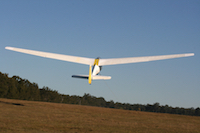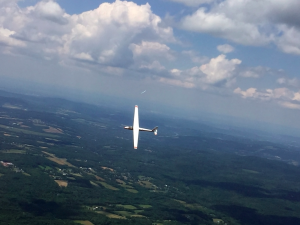On This Page:
1. The “Air Experience Flight” (Joyflight)
2. What to Expect
3. What to do on the Day of your Flight
5. Make a Booking
.
1. THE AIR-EXPERIENCE FLIGHT:
You might be wondering why we’re stumbling over the terms “Joyflight” and “Air Experience Flight”
It’s a legal thing.
If you take a “joyflight”, you are legally a passenger in the aircraft. Costs to you (and to us) are much higher, and we are not permitted to teach you about flying nor allow you to touch the controls of the sailplane.
When you take an “Air Experience Flight”, we register you as an Australian Trainee Pilot for thirty days. Training flights are much cheaper than passenger flights. We are also permitted to offer you a broader experience by including some basic pilot training in your flight.
Your training will begin with an introduction to the airframe and the controls of the sailplane. You will be given basic instruction in identifying and interpreting the flight instruments. You will be invited to go “hands-on” the controls so that you can feel how your instructor is controlling the sailplane. If time permits, your instructor will offer you the opportunity to take full control of the aircraft for some straight-and-level flight and some banked turns.
Of course, you have the right to waive these trainee privileges if you would rather simply enjoy the experience. You can let the instructor do all the work … just let us know the level of involvement that you desire.
.
2. WHAT TO EXPECT:

Grafton Gliding Club uses the Winch Technique to launch our sailplanes. Just before launch a rope will be attached to a mechanism on the belly of the sailplane. The rope stretches the length of the airfield to a winch fitted with a powerful engine. On the command “Full Power, Full Power”, the winch-driver will rapidly accelerate the sailplane to a speed of fifty knots (93kmph). The sailplane will become airborne after about twenty-five metres and soon after, your instructor will pull up into a surprisingly steep climb. The entire launch sequence takes a little over thirty seconds.
By that time, the sailplane will have climbed to an altitude of around 1,200 feet. The instructor will release the rope, establish level flight and decelerate to the sailplane’s cruising speed, a little above forty knots (75kmph). He or she will invite you to go “hands-on” the controls with them so that you can experience how to pilot an aircraft. Together you will make a series of gentle turns as you search for columns of warm rising air called “thermals”. The locations of thermals are often marked by fat fluffy clouds and by eagles circling in the sky.

Yes, our motto is true! The environment around South Grafton supports a healthy population of Wedgetail eagles with smaller populations of Sea Eagles, Brahminy Kites and Whistling Kites. There is a very good chance of spotting some raptors “on the wing” during your flight.
Your instructor will teach you how to feel the sailplane soar (lift) as it enters a thermal. During your early flights, you may rather use the flight instrument called the variometer. It has a needle that indicates when you enter a thermal. If you choose to extend your Intro Flight, you will begin flying in circles just as the eagles do. The objective will be to circle within the thermal until it carries the sailplane up to an altitude between 2,000ft and 2,500ft.

Your instructor will then demonstrate how to control the sailplane in level flight and how to execute turns. He or she will invite you to take sole command of the sailplane.
The sailplane will gradually descend during your time as pilot-in-command. At 800ft above ground, your instructor will resume control of the sailplane, accelerate to fifty knots and begin the “landing circuit”. This procedure, used by all aircraft, enables pilots to touch down precisely where they intend.

You will be returned to your life as a ground-creature …
but your memories of being sky-borne will remain.
… or as one pilot said to me on my first day of training …
“You’ll never look at the sky in the same way again”
If you would like to know more about flying a sailplane or the sport of gliding, please visit our “Links” page.
.
3. WHAT TO DO ON THE DAY OF YOUR FLIGHT:
Pre-Flight Check In:
Weather conditions must be assessed before each flying day. Please contact Graham between 7:30am and 8:00am on the morning of your flight to confirm that your flight can proceed as planned.
Arriving at the Aerodrome:
You will need to allow time for on-field transport and to complete some paperwork, so it is best to arrive at the aerodrome about thirty minutes before your flight time. We ask that you nominate a time for your flight and inform us of any changes. That will assist us to organise the flying schedules of our aircraft to everyone’s benefit.
Upon your arrival, contact Bob on 0403 088 551 or Graham on 0447 280 167. We will send a vehicle to transport you to the launch area. Let us know if you will not have a mobile phone. We will send a vehicle to the carpark thirty minutes before your flight time and each fifteen minutes after that until we contact you.
Please remain in the carpark until your transport arrives. We share the aerodrome with numerous pilots and aircraft. Movement of persons and vehicles on airfields is governed by legal regulations, safety considerations and community etiquette.
What to Bring (and what to leave behind):
Bring sunscreen, sunglasses and a drink. There will be a sun shelter and seating for yourself and your family or friends. Climbing into a sailplane is similar to climbing into a boat so choose clothing which will allow you to swing your legs “over the side”. We recommend that you wear a hat or cap. A floppy hat is best … but avoid wearing a hat with a high crown or broad brim. Wear shoes that are suitable for driving a car. Consider wearing long sleeves for sun protection. Take your preferred medication if you are likely to experience motion sickness. Kwells and Travacalm seem to work well for many people.
You may take a camera with you during your flight however we must insist that you attach it to your wrist with a strap or be able to stow it securely in your pocket when you are not using it.
Remove any loose items such as keys, coins and mobile phones which might fall from your pocket and interfere with the controls of the aircraft. Please note that caps with a “button” on top are not permitted … the button can become a safety hazard should the aircraft enter strong turbulence. Pets are not encouraged. If you need to bring a pet it must be securely restrained.
.4. MAKING A BOOKING:
Go to our Make a Booking page to reserve your Air-Experience Flight.
